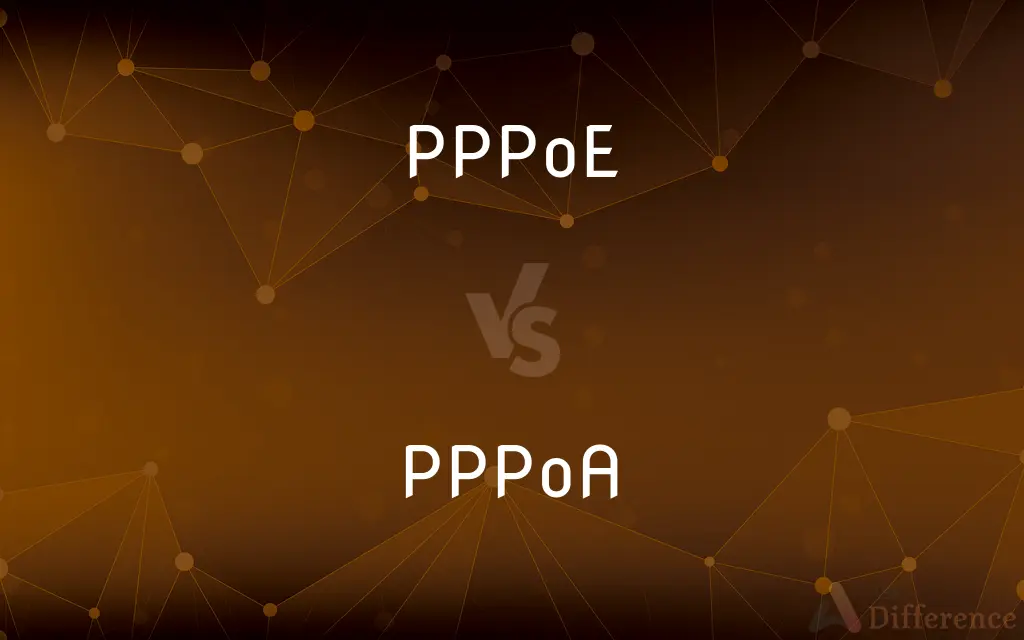PPPoE vs. PPPoA — What's the Difference?
By Tayyaba Rehman — Published on November 4, 2023
PPPoE means Point-to-Point Protocol over Ethernet, and PPPoA means Point-to-Point Protocol over ATM. PPPoE is more common in North America and provides connectivity over Ethernet, PPPoA is used mainly in Europe and provides connectivity over ATM networks.

Difference Between PPPoE and PPPoA
Table of Contents
ADVERTISEMENT
Key Differences
PPPoE, or Point-to-Point Protocol over Ethernet, is a network protocol used to connect multiple network users on an Ethernet local area network. PPPoA, or Point-to-Point Protocol over ATM, is a network protocol that operates over ATM virtual circuits. Both protocols are used to establish direct connections between two nodes in a network, but they operate over different types of network architectures and are used in different regional markets.
PPPoE is commonly used in broadband connections and has become more prevalent, particularly in North America, because it allows for a simple setup and does not require extensive configuration. PPPoA, on the other hand, is more common in European countries and requires compatible equipment, making it less popular as technology has advanced and other options have become easier to implement.
PPPoE operates over a simpler network structure and is often considered more stable due to its use of Ethernet, a widely adopted standard. PPPoA, however, operates over ATM networks, which can introduce more variables and potential points of failure, particularly as these networks age and become less common.
PPPoE allows for multiple users on a local area network (LAN) to share a common Digital Subscriber Line (DSL) connection, which is its primary use today. PPPoA is often used for individual, dedicated connections and can offer slightly faster speeds due to lower overhead but is less adaptable to modern, multiple-user networks.
PPPoE is often the standard choice for network administrators because of its compatibility with modern networks and its balance of speed, reliability, and ease of use. PPPoA, while once more common, has become increasingly niche as PPPoE and other technologies have become more standardized.
ADVERTISEMENT
Comparison Chart
Network Type
Operates over Ethernet
Operates over ATM
Geographical Use
More common in North America
More common in Europe
Configuration
Simpler, less equipment needed
Requires specific compatible equipment
Connection Type
Used for multiple users on a LAN
Often used for individual connections
Popularity
More widely adopted due to ease of use
Less common, becoming niche
Compare with Definitions
PPPoE
A communication protocol used in broadband connections over Ethernet.
Most residential routers use PPPoE for DSL internet connections.
PPPoA
A network protocol that operates over ATM virtual circuits.
My internet service provider uses PPPoA, which is common in this part of Europe.
PPPoE
A widely adopted standard in North America for broadband internet.
PPPoE is so prevalent that most routers come pre-configured for it.
PPPoA
A communication protocol for DSL internet connection over ATM networks.
Due to the infrastructure here, we need a router that supports PPPoA.
PPPoE
A protocol offering a balance of speed, reliability, and ease of use.
For most users, the benefits of PPPoE outweigh the simplicity of other connection methods.
PPPoA
A protocol used mainly in Europe for broadband connections.
PPPoA is not as common in the United States as it is in Europe.
PPPoE
A network protocol that allows multiple users to share a DSL connection.
To connect to the internet, you may need to set up a PPPoE configuration on your router.
PPPoA
Known for lower overhead and potentially faster speeds.
PPPoA can offer faster connection speeds, but it requires specific equipment.
PPPoE
A protocol that allows for a single, shared connection in local area networks.
With PPPoE, we can have multiple computers connected to the internet using just one modem.
PPPoA
A less adaptable protocol requiring more specific configurations.
Using PPPoA limits our options for network expansion due to its strict requirements.
Common Curiosities
Can I choose between using PPPoE and PPPoA?
The choice depends on your ISP's infrastructure and the technology they use. It's not typically a user's choice.
Why is PPPoA less common now?
PPPoA's reliance on aging ATM networks and the need for specific hardware make it less practical as technology advances.
Can PPPoE and PPPoA be used interchangeably?
No, they operate over different network types and hardware. Compatibility with the service provider's infrastructure is crucial.
What's the configuration process for PPPoE?
PPPoE typically requires minimal configuration, often just a username and password for your ISP connection.
Are there speed differences between PPPoE and PPPoA?
PPPoA can be slightly faster due to lower overhead, but this difference is often negligible for most users.
What is the main function of PPPoE?
PPPoE allows multiple users on a LAN to share a single broadband connection, typically DSL.
Why might an ISP choose PPPoA over PPPoE?
ISPs might prefer PPPoA due to existing ATM infrastructure, especially in certain European regions.
Is PPPoE suitable for larger networks with multiple users?
Yes, PPPoE is ideal for LANs and residential networks with multiple devices.
Why is PPPoE more popular in North America?
PPPoE is more common due to its simplicity, ease of setup, and compatibility with most modern routers and networks.
Do I need special equipment for a PPPoA connection?
Yes, PPPoA requires a compatible modem and router that can handle ATM virtual circuits.
Are there security differences between PPPoE and PPPoA?
Both protocols have similar security levels, but the overall security also depends on other factors like network configuration and hardware.
Can PPPoA support multiple users on a single connection?
Typically, PPPoA is used for individual, dedicated connections, not multiple-user networks.
Are PPPoE and PPPoA still relevant with the advent of fiber optics?
They are less relevant as newer technologies emerge, but they are still in use, particularly in regions with existing infrastructure.
Is one protocol faster than the other?
PPPoA might offer slightly faster speeds due to lower overhead, but it's often not noticeable to the average user.
Do I need a specific router for PPPoE?
Most modern routers support PPPoE without the need for special equipment.
Share Your Discovery

Previous Comparison
DLC vs. Expansion Packs
Next Comparison
Black vs. Jet BlackAuthor Spotlight
Written by
Tayyaba RehmanTayyaba Rehman is a distinguished writer, currently serving as a primary contributor to askdifference.com. As a researcher in semantics and etymology, Tayyaba's passion for the complexity of languages and their distinctions has found a perfect home on the platform. Tayyaba delves into the intricacies of language, distinguishing between commonly confused words and phrases, thereby providing clarity for readers worldwide.














































